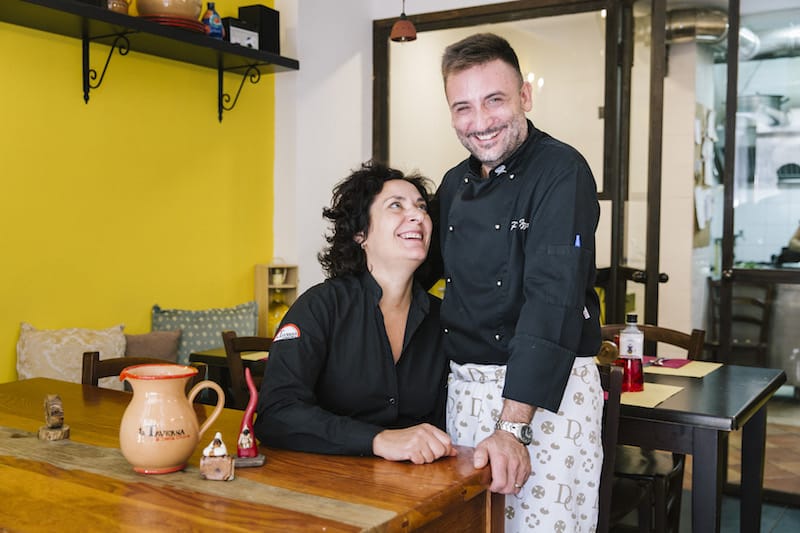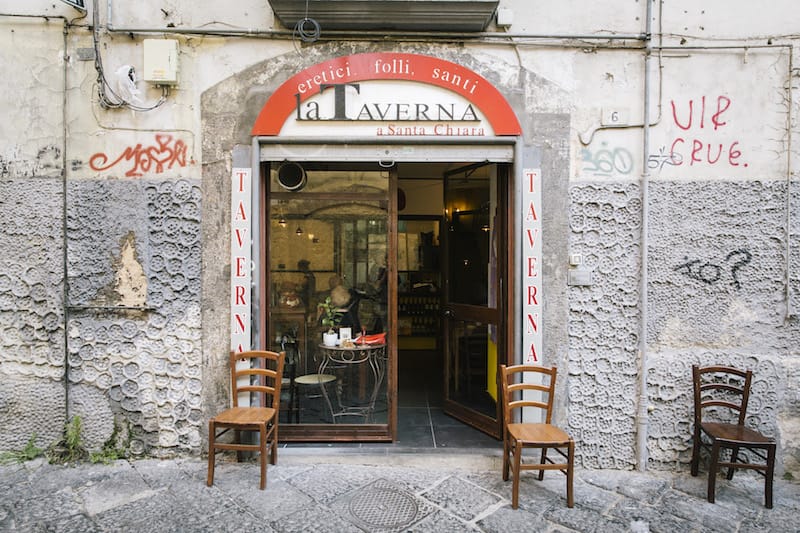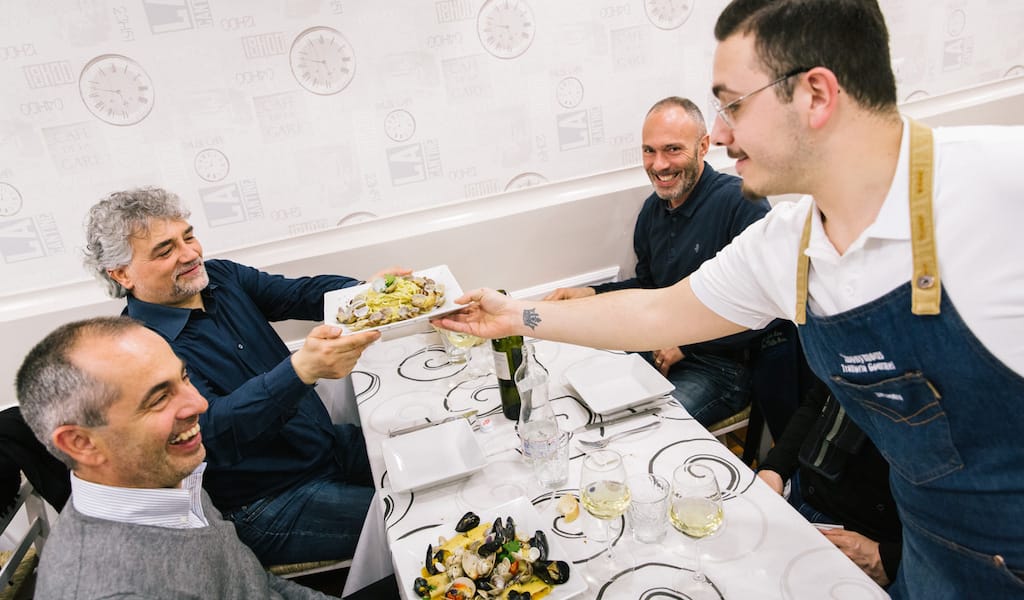Take a small space in a strategic location, add two young and idealistic owners, and finish with traditional Neapolitan dishes made with the finest raw ingredients – this is Taverna a Santa Chiara’s recipe for success.
Everything began with the passion of two young Neapolitans, Nives Monda and Potito Izzo, for specialty artisanal food products from the Campania region. These types of products are not necessarily hard to find – Campania is home to many excellent small producers. Yet high quality often comes at a high cost, especially when compared to mass industrial products sold through large distribution chains.
So Nives and Potito (two very unusual names in southern Italy) decided to create a space in Naples where customers could taste a wide range of high-quality Campania food items. The end result is Taverna a Santa Chiara, a modern tavern whose greatest strength is the choice of regional and seasonal products mostly made by small producers.

The two partners managed to create a simple menu filled with high-quality raw materials at a reasonable price point by bypassing distributors and sourcing directly from producers. With this approach, they were able to reduce considerably the costs of these products, which include red sausage from Castelpoto (a Slow Food Presidium product), dairy products made of noble milk, or latte nobile, produced by cows that are fed only herbs and hay that’s naturally free of GMOs and filler, and Giovanni Pucciarelli’s organic vegetables and olive oil.
“It’s a different restaurant idea,” says Nives. “The producers deliver their products at low prices, and the tavern manages to make traditional dishes with specialty products.”
A labor consultant for 20 years, Nives used to study union relations before turning her attention to our relationship with food.
Potito Izzo, whom Nives calls a “comfort food chef,” has always been faithful to the cuisine of Neapolitan home cooks and families. He and Nives have been friends for over 10 years, but their business partnership began around five years ago, when Potito embraced Nives’ idea to open a tavern.
In April 2013, the duo took over the historic trattoria of Titina e Gennaro, which had sat next to the bell tower of the magnificent Santa Chiara religious complex, a few steps from Piazza del Gesù, where the city’s pedestrian center begins, since the early 1900s.
They see themselves as continuing a gastronomic tradition, but with a new focus on products of exceptional quality.
“Even today tourists come and ask us about Titina e Gennaro, a sign that it left a mark on the memory of the city,” Nives says. They see themselves as continuing a gastronomic tradition, but with a new focus on products of exceptional quality.
Every day the tavern prepares at least three first courses, all closely linked to Neapolitan cuisine.
One of their classic first dishes is the maccheroncini alla brigante, made with Roman Conciato cheese, which despite its name is traditionally made in Campania and is believed by many to be Italy’s oldest cheese, dating back to the Samnite civilization.
We never miss the ziti al ragù (the traditional Neapolitan meat sauce), one of the Neapolitan cuisine’s most iconic dishes. “Ziti” are an ancient type of pasta; in the Neapolitan language, “zite” are unmarried women, and so the pasta is called that because it was the best quality macaroni that was reserved for the marriage of the zite.
Potito’s ragù is made with Neapolitan braciole (a roll of lean meat cooked in tomato sauce), and the meat becomes a typical second course, along with Neapolitan meatballs.
And then there’s the rigatoni with a unique “Genovese” sauce: the historic Neapolitan dish with onions is here made with octopus (although they also serve the meat version).
As for the main course, there are many options – in addition to meat mains, there are also a good number of legume and fish dishes. Don’t miss the cicerchie e baccalà, salt cod and a legume that’s a cross between beans, chickpeas and fava beans, one of the restaurant’s historic dishes.

The open kitchen and the familiar atmosphere of the lower room give the tavern a homely feel; the upstairs dining room is quieter, with a delightful balcony overlooking the bell tower of Santa Chiara.
“This is a place where not only do you eat well but you feel good,” says Enrico, a tour guide with a couple of tourists in tow.
Two years ago, Slow Food included Taverna a Santa Chiara in its Osterie d’Italia guide. While regular customers have always known the quality of the tavern, this recognition by Slow Food is further proof.
“It was a very important result,” Potito tells us, because the concept behind Slow Food’s guide is “the spirit in which we founded the tavern: a popular place where a region’s great raw materials are offered in dishes that look to ancient traditions, and above all at a price accessible to everyone.”
It’s so affordable that some regulars come here for dinner at least twice a week. “It is also a meeting place for musicians, promoters of cultural events,” says Lino, one such regular.
But the greatest satisfaction for chef Potito came this year: the 2018 Slow Food recipe book includes two of his creations.
The first one is his rigatoni with the octopus Genovese. The second is the dessert for which the tavern is famous: the migliaccio, a semolina and ricotta cake.
Here it is made just as the ancient recipe reads. So of course, we can’t finish our lunch without ordering Potito’s heavenly migliaccio.
Published on October 11, 2018
Related stories
July 24, 2019
NaplesThe Neapolitan stairs are ancient urban routes that connect the upper city (the Vomero district) to the lower city (the historic center). The most famous of these stairs is the Pedamentina di San Martino, a staircase of 414 steps dating back to the 14th century, which starts from the old center and reaches the Castel…
November 2, 2018
NaplesThe team behind Salumeria Upnea, a modern trattoria cum exhibition space in Naples, is not exactly what you’d expect: Gennaro, Luigi, Stefano and Antonello, three pharmaceutical researchers and one lawyer, respectively, were deskbound at a pharmaceutical company not that long ago. Yet these four friends decided to risk everything for their two passions: photography and…
Explore the ancient streets of Naples on our culinary walk!
April 1, 2019
NaplesRua Catalana is a very ancient road, a corner of Naples where time seems to stand still. Located next to the financial district and now squeezed by 19th-century buildings, it is curiously the only road in the city that, instead of the Italian “Via,” uses “Rua,” a distortion of the French “Rue.” In the mid-14th…



















































































